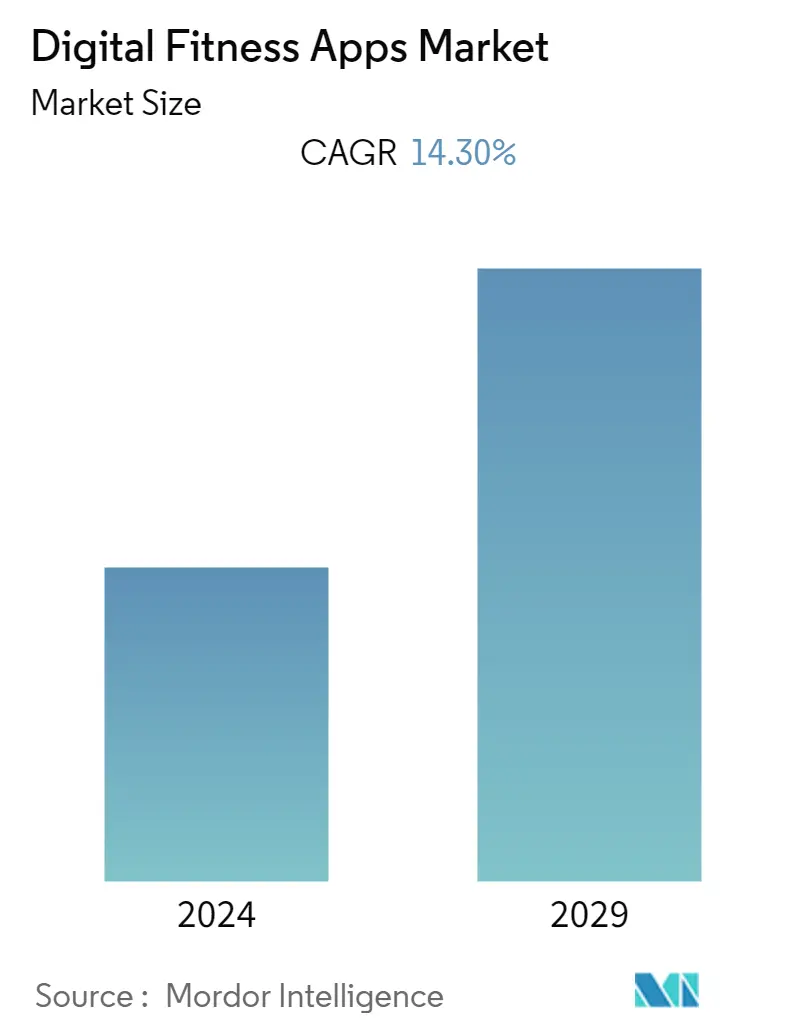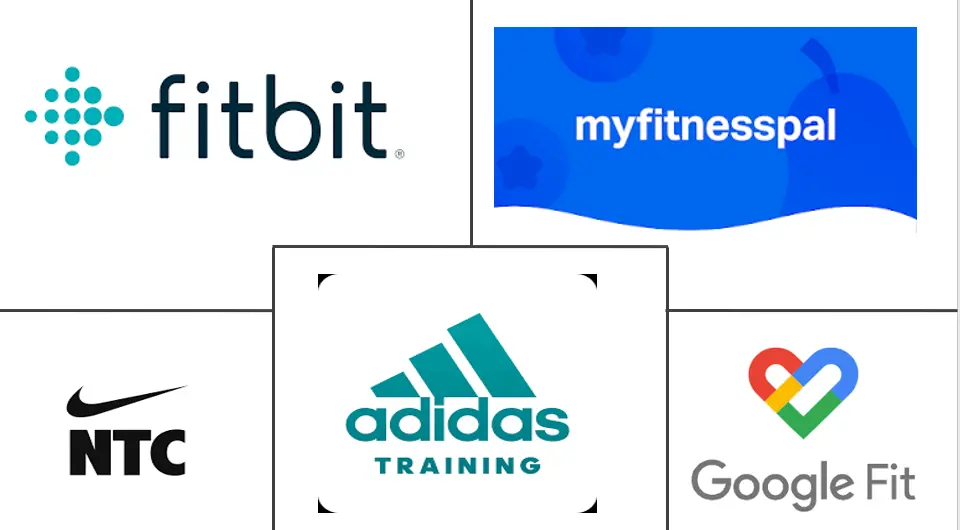Market Size of Digital Fitness Apps Industry

| Study Period | 2019 - 2029 |
| Base Year For Estimation | 2023 |
| Forecast Data Period | 2024 - 2029 |
| CAGR | 14.30 % |
| Largest Market | North America |
| Market Concentration | Low |
Major Players
*Disclaimer: Major Players sorted in no particular order |
Digital Fitness Apps Market Analysis
The Digital Fitness Apps Market is expected to grow at a CAGR of 14.3% for the next five years. This can be attributed to the increase in demand for in-app purchases and the dependence of global digital lifestyles on adopting mobile apps. The increased emphasis on maintaining a healthy lifestyle mainly generates the market for fitness apps.
- The market is expanding due to rising smartphone usage globally and rapid technological advancement. The industry is also being expanded by rising data usage, the widespread use of the internet, and a rise in promotional offerings such as subscription discounts. Due to information technology improvements, the fitness industry's operating model is about to change rapidly in the forecast period.
- The fitness apps use emerging technologies for artificial intelligence, machine learning, and several new innovative technologies that track the users' daily routine and provide them with a customized diet, workout, walking, and sleep cycle plans without any machine or equipment. The program keeps an eye on human activity 24/7. Thereby, it is the most effective way of tracking health conditions without much human intervention.
- A typical fitness app gathers information from many wearable gadget sensors. Some sensors are worn on the user's wrist, while others are portable and fit in their pocket. Additionally, the company that created the fitness app allows users to add data to the app manually. Hackers can acquire confidential information like credit or debit card numbers if they get access to the device.
- At present, people around the world have become much more health conscious, especially after the Covid-19 pandemic. Also, obesity and weight gain are causes of concern for the young generation due to improper eating habits, junk food intake, and adverse work-life stress. Newly developed fitness apps concentrate on weight loss tracking measures and provide mental health solutions. That is why fitness apps are largely adopted globally, and the market is expected to witness growth in the coming years.
- During the adverse phase of the pandemic, there was a global state of lockdown. gyms and fitness studios had no choice but to enhance their online presence while the building was under lockdown. COVID-19 enhanced users' transition from conventional studios and gyms to virtual training platforms, quickly increasing the number of fitness app downloads and subscriptions.
Digital Fitness Apps Industry Segmentation
The Digital Fitness & Well-Being Apps provide health and fitness tools for identifying, tracking, assessing, and comparing fitness progress. They also include diet and nutrition applications, which enable users to track and evaluate their eating habits to make better nutritional and health decisions. Additionally, contraception and fertility applications improve users' knowledge, offer monitoring features, and give them instructions on themes like self-care, family planning, and birth control. Apps for meditation include those that support users' ability to maintain composure under pressure, manage their emotions, and focus on the present moment.
The Digital Fitness Apps Market is segmented by Type (Fitness Apps Tracking Fitness Achievements, Nutrition Apps, Meditation Apps, Contraception and Fertility Apps, and Medication Checker Apps) and Geography (North America, Europe, Asia Pacific, Latin America, and the Middle East and Africa). The market sizes and forecasts are provided in terms of value (USD million) for all the above segments.
| By Type | |
| Fitness Apps Tracking Fitness Achievements | |
| Nutrition Apps | |
| Meditation Apps | |
| Contraception and Fertility Apps | |
| Medication Checker Apps | |
| Others Mindfulness Apps |
| By Geography | |
| North America | |
| Europe | |
| Asia Pacific | |
| Latin America | |
| Middle East and Africa |
Digital Fitness Apps Market Size Summary
The Digital Fitness Apps Market is experiencing significant growth, driven by the increasing demand for mobile applications that support healthy lifestyles. This expansion is fueled by the widespread adoption of smartphones and rapid technological advancements, which have made fitness apps more accessible and user-friendly. The market is further bolstered by the integration of emerging technologies such as artificial intelligence and machine learning, enabling apps to offer personalized fitness and wellness plans. The shift from traditional gyms to virtual platforms, accelerated by the COVID-19 pandemic, has also contributed to the surge in app downloads and subscriptions. As consumers become more health-conscious, particularly in the wake of the pandemic, fitness apps that focus on weight management and mental health solutions are gaining popularity worldwide.
North America holds a substantial share of the digital fitness apps market, with the United States leading due to its technological innovation and high mobile app adoption rate. The presence of major companies like Fitbit, Nike, and Google, along with government initiatives promoting digital health, supports the region's market growth. The increasing prevalence of chronic diseases among the aging population further drives the demand for fitness apps that facilitate continuous health monitoring and communication with healthcare professionals. The market is highly fragmented, with key players continuously advancing their offerings and expanding their global presence. Collaborations and integrations, such as Google's Health Connect, are enhancing the functionality and appeal of fitness apps, ensuring sustained growth in the coming years.
Digital Fitness Apps Market Size - Table of Contents
-
1. MARKET INSIGHTS
-
1.1 Market Overview
-
1.2 Industry Attractiveness- Porter's Five Forces Analysis
-
1.2.1 Bargaining Power of Suppliers
-
1.2.2 Bargaining Power of Consumers
-
1.2.3 Threat of New Entrants
-
1.2.4 Threat of Substitute Products
-
1.2.5 Intensity of Competitive Rivalry
-
-
1.3 Impact of COVID-19 on the Industry
-
-
2. MARKET SEGMENTATION
-
2.1 By Type
-
2.1.1 Fitness Apps Tracking Fitness Achievements
-
2.1.2 Nutrition Apps
-
2.1.3 Meditation Apps
-
2.1.4 Contraception and Fertility Apps
-
2.1.5 Medication Checker Apps
-
2.1.6 Others Mindfulness Apps
-
-
2.2 By Geography
-
2.2.1 North America
-
2.2.2 Europe
-
2.2.3 Asia Pacific
-
2.2.4 Latin America
-
2.2.5 Middle East and Africa
-
-
Digital Fitness Apps Market Size FAQs
What is the current Digital Fitness Apps Market size?
The Digital Fitness Apps Market is projected to register a CAGR of 14.30% during the forecast period (2024-2029)
Who are the key players in Digital Fitness Apps Market?
Adidas, Nike, Firbit Inc, Google and MyFitnessPal Inc. are the major companies operating in the Digital Fitness Apps Market.

